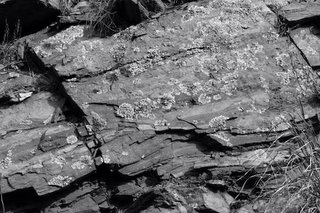
While walking the road from the observatory up to the peak of Mt. Bigelow, where most of Tuscon's TV stations have their antennas, this rock outcrop caught my attention. The sun played across the layers of cracked and broken Sedimentry rock that hundreds of millions of years ago was at the bottom of an ocean. Today, it forms a small cap along the northern ridge line of the Catalinas, 9000 feet above Sea Level. The core of the Catalinas are Granite. Across the surface of the outcrop, you can see frilly, flowery shaped lichens, which are actully a fungus and an alge living together. They get their nutrients by litterally eating the rocks on which they live. Canon 20D - 1/320th, 86mm @ f/20, ISO 800.
 While walking the road from the observatory up to the peak of Mt. Bigelow, where most of Tuscon's TV stations have their antennas, this rock outcrop caught my attention. The sun played across the layers of cracked and broken Sedimentry rock that hundreds of millions of years ago was at the bottom of an ocean. Today, it forms a small cap along the northern ridge line of the Catalinas, 9000 feet above Sea Level. The core of the Catalinas are Granite. Across the surface of the outcrop, you can see frilly, flowery shaped lichens, which are actully a fungus and an alge living together. They get their nutrients by litterally eating the rocks on which they live. Canon 20D - 1/320th, 86mm @ f/20, ISO 800.
While walking the road from the observatory up to the peak of Mt. Bigelow, where most of Tuscon's TV stations have their antennas, this rock outcrop caught my attention. The sun played across the layers of cracked and broken Sedimentry rock that hundreds of millions of years ago was at the bottom of an ocean. Today, it forms a small cap along the northern ridge line of the Catalinas, 9000 feet above Sea Level. The core of the Catalinas are Granite. Across the surface of the outcrop, you can see frilly, flowery shaped lichens, which are actully a fungus and an alge living together. They get their nutrients by litterally eating the rocks on which they live. Canon 20D - 1/320th, 86mm @ f/20, ISO 800.


2 Comments:
Hey Rich, did you shoot this in B&W or did you convert it after the fact? The 20D does a great job of B&W and is fun to play with if you get the chance, but I have to admit, I usually convert after the fact before posting. I hate to throw anything away and storing B&W on camera almost seems like a waste, so that's some momentum that is hard to overcome, but might be worth some experiments. I've been meaning to get back to playing with all the features on this great little machine - there's so much to learn, eh?! I suppose we could challenge ourselves by picking a function on the camera and trying to get the most out of it - that might be the only way I'd shoot in sports/action mode instead of Aperture priority.... :-)
The shot of the rain a few weeks ago was shot with the B&W mode, but this one was shot in color. I then opened it in Photoshop and looked at each of the colors, R,B, & G to see which one gave the most pleasant results. After chosing, I converted to grayscale. A small change in the levels to make the flat parts of the histogram at the bright and dark ends fully black & white. A light unshapr mask and finally converted it back to RBG before the final size reduction posted here.
I agree about the challenge!
I've been reading about and playing with the AWB & Color Temps to see what it produces.
Post a Comment
<< Home